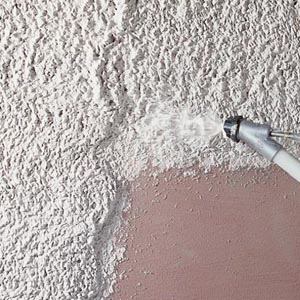Gypsum plaster characteristic
Gypsum plaster is a white cementing substance that is created by partially or completely drying the mineral gypsum. frequently with the addition of other materials like sand, cement, and water. It is a material that can be applied over brick, block, or concrete surfaces to form a smooth surface. Gypsum plaster replaces Portland cement with gypsum as a binding substance. It is widely used in interior construction due to its properties. such as no curing time required, high productivity, high performance, smooth finish, and low thermal conductivity. Gypsum plaster is also preferred by developers as part of the interior plastering as it saves cost.

gypsum plaster History
Gypsum plaster has been used for thousands of years in various forms of construction and decoration. Here is a brief history of gypsum plaster.
Ancient times. Gypsum was considered beautiful and durable and was used as a stone, road paving, and sculpture material. Its processing technology was passed down from Persia to Greece. And then the Romans incorporated it into construction techniques that eventually spread widely in Europe. Plaster of Paris is a common name, due to the abundance of gypsum near Paris, France.
7000 B.C. The first evidence of the using gypsum in building construction appears to have occurred when the Egyptians used gypsum blocks. And also applied it to the outer layers of the Pyramids at Giza. Alabaster, or crystallized gypsum, was used in sarcophagus building.
1700 BC. Vibrant gypsum wall frescoes enlivened Mycenaean living quarters.
16th century. Gypsum was being used in the 16th century with lime in floors, walls, and ceilings, but decorative plasterwork. which was previously assumed to contain gypsum, is proving to contain only minute traces.
Modern times. Today, gypsum is widely used in interior construction due to its properties. such as no curing time required, high productivity, high performance, smooth finish, and low thermal conductivity.
Overall, gypsum has a long and rich history of use in construction and decoration. and it continues to be a popular choice for interior construction today.
Gypsum plaster advantages
Gypsum plaster is a popular choice for interior construction due to its many advantages. Here are some of the advantages of it.
- Ease of Application (Workability). Gypsum can be directly applied over brick/block work without separate finishing. It is also very easy to apply and level gypsum plaster.
- No curing time required. Unlike traditional cement plaster, gypsum doesn’t need any curing, saving water and time during construction.
- High Productivity. Gypsum reduces time considerably when compared to conventional cement plaster.
- High Performance. Gypsum plaster has excellent high strength after drying, is durable, and lightweight, which reduces the dead load on the structure.
- Smooth Finish. Gypsum provides perfectly lined, leveled, smooth walls, and perfect right-angled corners.
- Fire resistant. Gypsum plaster is highly resistant to fire.
- Low thermal conductivity. Gypsum has low thermal conductivity, which saves electrical cost for heating and cooling rooms in a building.
- Excellent acoustic and thermal properties. Gypsum plaster offers excellent acoustic and thermal properties while giving leveled walls with the best finish.
Overall, gypsum is a great choice for interior construction due to its superior finish, time-saving attributes, and other advantages.
Gypsum plaster disadvantages
This material is a popular choice for interior construction due to its many advantages, but it also has some disadvantages. Here are some of the disadvantages of gypsum plaster.
Disadvantages:
- Unsuitable for damp areas. Gypsum is not moisture-resistant and hence unsuitable for damp areas such as bathrooms, basements, balconies, or kitchens.
- Not suitable for exterior walls. Gypsum plaster is unsuitable for exterior walls due to its susceptibility to moisture, especially continuous moisture exposure.
- Limited application. Gypsum is suitable only for interior plastering.
- Requires skilled labor. Gypsum plaster requires skilled labor for application and finishing.
- Cost. Gypsum is more expensive than traditional cement plaster.

Gypsum plaster usage
Gypsum is a versatile material that can be used in many ways in interior construction. Here are some common uses of gypsum plaster.
Wall and ceiling plastering: Gypsum is commonly used for plastering interior walls and ceilings. It provides a smooth finish and is an ideal base for good quality paints and wallpaper finishes.
False ceilings: this material can be used to create false ceilings. which are suspended below the main ceiling and can be used to hide wiring, ducts, and other services.
Decorative elements: Gypsum can be molded into decorative elements such as cornices, ceiling roses, and arches.
Insulation: It has good insulation properties. and it can be used as a heat-insulating material to protect wood or metal columns and beams from high temperatures.
Fire protection: Gypsum is highly resistant to fire. and it can be used to provide fire protection to interior walls and ceilings.
Soundproofing: Gypsum plaster offers excellent acoustic properties and can be used to soundproof interior walls and ceilings.
Overall, gypsum is a versatile material that can be used in many ways. Like in interior construction, providing superior finish, time-saving attributes, and other advantages.
Precautions for storing gypsum plaster
Here are some precautions for storing gypsum plaster.
Store in dry conditions. Gypsum should be stored in dry conditions to prevent exposure to moisture. If exposed to high humidity, plasterboard products may sag or lose their strength.
Keep bags sealed. Gypsum is sold in bags of 20-40 kgs. While storing, make sure that the package is tight and sealed for use as gypsum plaster.
Store on elevated surface. When storing gypsum plaster bags at the construction site, they must be stored on an elevated surface. Which is made of concrete, timber, or brick. Place the bags away from walls and other masonry surfaces as this may expose the bag to water or moisture.
Avoid moisture exposure. Do not expose the bags to moisture. As this reduces the setting time of the plaster and adversely impacts the strength of the gypsum. The gypsum plaster bags should be stored. so that there is no possibility of the bag getting in contact with water or moisture content.
Check storage time. In areas with higher than 90 degrees humidity, storing time for gypsum bags must not be more than 6 weeks. The shelf life of to-be-applied gypsum is 3-4 months from the date of manufacture and production. But, if stored properly with optimal care and proper environment, the shelf life can be extended by another six months.
Overall, proper storage of gypsum plaster is important to ensure its quality and effectiveness during application.

